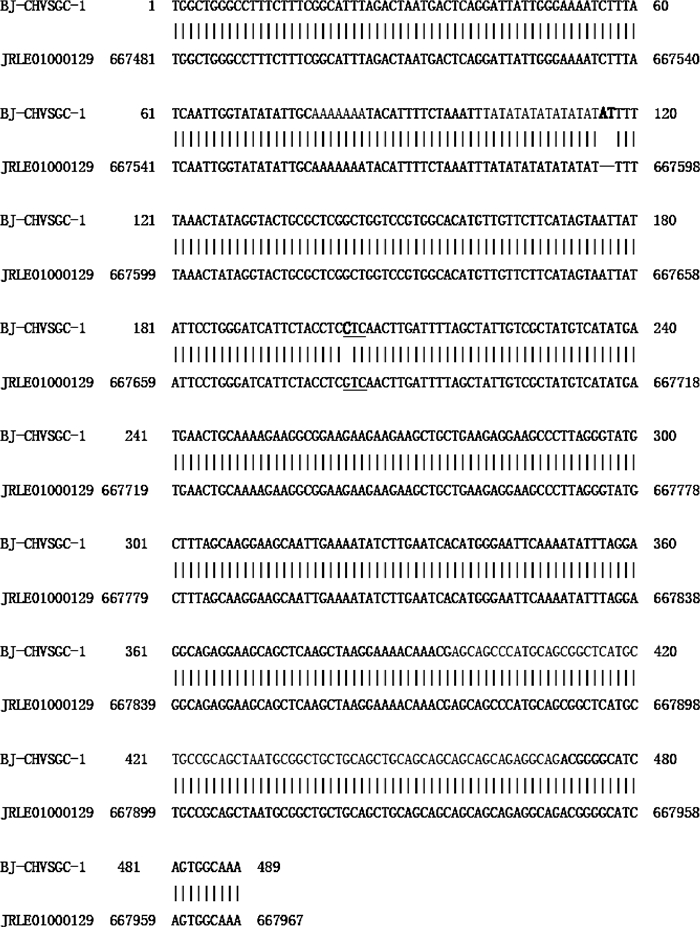扩展功能
文章信息
- 刘念, 周小洁, 戚广浩, 李梅, 邱星辉
- LIU Nian, ZHOU Xiao-jie, QI Guang-hao, LI Mei, QIU Xing-hui
- 北京市温带臭虫击倒抗性基因突变检测
- Detection of knockdown resistance mutations in a Cimex lectularius field population in Beijing, China
- 中国媒介生物学及控制杂志, 2019, 30(5): 524-527, 544
- Chin J Vector Biol & Control, 2019, 30(5): 524-527, 544
- 10.11853/j.issn.1003.8280.2019.05.010
-
文章历史
- 收稿日期: 2019-04-25
- 网络出版时间: 2019-08-07 07:00
2 北京市疾病预防控制中心, 北京 100013;
3 北京市通州区疾病预防控制中心, 北京 101100
2 Beijing Center for Disease Control and Prevention;
3 Tongzhou District Center for Disease Control and Prevention
臭虫属于半翅目臭虫科昆虫,靠吸食血液生殖繁衍[1]。中国常见的臭虫有温带臭虫(Cimex lectularius)和热带臭虫(C. hemipterus)2种[2]。人被臭虫叮咬后会出现皮肤红肿、瘙痒等免疫反应症状,从而引起焦虑和失眠等[3]。
电压门控钠离子通道(voltage gated sodium channel,VGSC)是拟除虫菊酯类和有机氯类杀虫剂的主要作用靶标[4]。击倒抗性(knockdown resistance,kdr)指因昆虫VGSC对药物的敏感度降低而引起的抗药性。击倒抗性现象最早在家蝇(Musca domestica)中发现,其分子基础主要是VGSC的1014位点发生了氨基酸替换,即由敏感型的亮氨酸(L)突变为抗性型的苯丙氨酸(F)。之后在冈比亚按蚊(Anopheles gambiae)、尖音库蚊(Culex pipiens)、德国小蠊(Blattella germanica)和臭虫等多种病媒昆虫中也发现VGSC的点突变与拟除虫菊酯类杀虫剂的抗性有关[4-5]。就温带臭虫而言,已发现V419L、L925I和I936F突变与拟除虫菊酯类杀虫剂抗性有关[6-8],本研究检测北京市温带臭虫中是否存在该基因的抗性突变。
1 材料与方法 1.1 材料于2018年9月采集北京市大兴区某公司宿舍的活体臭虫,带回实验室置-20 ℃冰箱保存。样品虫体前胸前缘凹陷较深,两端向外延伸成薄片状,前胸背板宽与长的比值在2.85~2.93之间,为温带臭虫[9-10]。
1.2 电压门控钠离子通道(vgsc)基因片段扩增参考Rinkevich等[11]的方法提取单只臭虫的基因组DNA,用nano drop测定样品的DNA浓度。以单只臭虫基因组DNA为模板,分两段扩增出vgsc中包含已知抗性位点的DNA片段:第1段采用引物BBpara-F和BBpara-R扩增,其产物包含419位点的密码子;第2段采用引物CHVG-SC-F和CHVG-SC-R(表 1),该扩增片段包含925位点以及936位点的密码子。PCR反应体系组成:2×Taq Master Mix(TIANGEN)12.5 μl;正、反向引物各6 μmol/L;DNA模板50~100 ng,无菌H2O加至25 μl。PCR反应条件:95 ℃ 2 min;94 ℃ 30 s;52 ℃或58 ℃ 30 s;72 ℃ 50 s;34个循环;72℃ 5 min。PCR产物用1.5%琼脂糖凝胶电泳检测,反向引物测序由北京擎科新业生物技术有限公司完成。

|
人工核实测序结果,检查测序质量以及是否存在杂合位点。核实结果与美国国立生物技术信息中心(NCBI)数据库中的核酸序列进行比对,验证是否为臭虫的vgsc序列。使用在线软件ClustalW2进行多序列比对,判别抗性相关位点的基因型。
2 结果 2.1 vgsc序列分析实验分别扩增出长度约为550和800 bp的PCR产物。将第1段(550 bp)测定结果在删除两端不可靠序列后,得到489 bp的有效序列,该段序列(BJ-CHVSGC-1)经BLAST N比对,与温带臭虫基因组测序结果(JRLE01000129.1)的对应区域有3处不同,即1个碱基替换和2个碱基插入(图 1)。第2段(800 bp)获得的751 bp有效序列(BJ- CHVSGC- 1)与JRLE01000129.1比对发现存在1个碱基差异(图 2)。相对于参考序列,本研究测定的样品第1段序列的碱基插入是在内含子区,不影响蛋白编码,但其碱基替换(由G变为C)为非同义替换,将导致编码的氨基酸由缬氨酸变为亮氨酸,即V419L(图 3A);第2段的碱基突变(C变为A)发生在外显子区,由此造成VGSC的L925I点突变(图 3B)。

|
| 图 1 北京市温带臭虫电压门控钠离子通道(vgsc)基因序列BJ-CHVSGC-1与基因组数据库对应序列比对结果 Figure 1 Alignment of the voltage gated sodium channel(vgsc)gene sequence BJ-CHVSGC-1 of Cimex lectularius in Beijing with the corresponding sequence from the genome database |
| |

|
| 图 2 北京市温带臭虫电压门控钠离子通道(vgsc)基因序列BJ-CHVSGC-2与基因组数据库对应序列比对结果 Figure 2 Alignment of the voltage gated sodium channel(vgsc)gene sequence BJ-CHVSGC-2 of Cimex lectularius in Beijing with the corresponding sequence from the genome database |
| |

|
| 注:抗性相关位点密码子加框指示;A.419L纯合(抗性型);B.925I纯合(抗性型);C.936I纯合(野生型) 图 3 北京市温带臭虫电压门控钠离子通道基因测序结果 Figure 3 Example chromatograms showing the codons of resistance-related loci in the voltage-gated sodium channel gene of Cimex lectularius in Beijing |
| |
3个抗性相关位点的分析显示,419和925位点为抗性纯合基因型,其密码子分别为CTC和ATT,编码亮氨酸和异亮氨酸,但936位点为敏感型ATT,而不是抗性基因型TTT(图 3)。6个样品的检测结果显示,VGSC 419和925位点的抗性突变频率为100%,而936位点的抗性突变频率为0(表 2)。

|
臭虫是20世纪常见的吸血昆虫,化学杀虫剂的使用对臭虫的控制发挥了重要作用[12]。但近年在中国、美国和澳大利亚等国家发现臭虫数量明显上升,工厂宿舍、出租房、火车上较多[13]。臭虫再次猖獗的原因包括频繁的国际旅行、有效防治方法的缺乏以及臭虫对杀虫剂的抗药性等。已在多个国家的臭虫种群中检测到拟除虫菊酯类杀虫剂有较高的抗药性[6, 14]。
温带臭虫VGSC点突变V419L和L925I可以造成臭虫对杀虫剂的敏感度降低[15]。研究表明,温带臭虫VGSC的V419L和L925I突变在世界范围内广泛分布[6],它们既可以单独发生,也可以共同存在(即双突变)。另一突变(I936F)与右旋丙烯菊酯的低水平抗性相关联[16],仅在澳大利亚和以色列的温带臭虫中检测到,且频率很低[7, 16],该突变对VGSC敏感性的影响还缺乏电生理学的实验数据。
本研究对温带臭虫vgsc基因编码419、925和936氨基酸位点的密码子进行检测,发现419和925位点同时发生了抗性相关的基因突变。检测的6个个体全部为抗性纯合基因型,抗性突变频率高达100%。尽管捕获和检测的个体有限,但双位点100%的突变频率说明该温带臭虫种群对拟除虫菊酯类杀虫剂的抗性水平较高。据此,应该加大北京市温带臭虫抗药性的检测范围,根据敏感性测定结果合理选择杀虫剂种类。在实施臭虫的化学防治时应制定相应的对策,选用与拟除虫菊酯类杀虫剂作用机制不同的其他药剂,或采用物理方法减少臭虫的危害。
| [1] |
Reinhardt K, Siva-Jothy MT. Biology of the bed bugs (Cimicidae)[J]. Ann Rev Entomol, 2007, 52: 351-374. DOI:10.1146/annurev.ento.52.040306.133913 |
| [2] |
Wang CL, Singh N, Cooper RA, et al. Evaluation of an insecticide dust band treatment method for controlling bed bugs[J]. J Econ Entomol, 2013, 106(1): 347-352. DOI:10.1603/EC12259 |
| [3] |
Susser SR, Perron S, Fournier M, et al. Mental health effects from urban bed bug infestation (Cimex lectularius L.):a cross-sectional study[J]. BMJ Open, 2012, 2(5): e000838. DOI:10.1136/bmjopen-2012-000838 |
| [4] |
Dong K, Du YZ, Rinkevich F, et al. Molecular biology of insect sodium channels and pyrethroid resistance[J]. Insect Biochem Mol Biol, 2014, 50: 1-17. DOI:10.1016/j.ibmb.2014.03.012 |
| [5] |
Sayono S, Hidayati APN, Fahri S, et al. Distribution of voltage-gated sodium channel (Nav) alleles among the Aedes aegypti populations in central Java province and its association with resistance to pyrethroid insecticides[J]. PLoS One, 2016, 11(3): e0150577. DOI:10.1371/journal.pone.0150577 |
| [6] |
Dang K, Doggett SL, Singham GV, et al. Insecticide resistance and resistance mechanisms in bed bugs, Cimex spp. (Hemiptera:Cimicidae)[J]. Parasit Vectors, 2017, 10(1): 318. DOI:10.1186/s13071-017-2232-3 |
| [7] |
Palenchar DJ, Gellatly KJ, Yoon KS, et al. Quantitative sequencing for the determination of kdr-type resistance allele (V419L, L925I, I936F) frequencies in common bed bug (Hemiptera:Cimicidae) populations collected from Israel[J]. J Med Entomol, 2015, 52(5): 1018-1027. DOI:10.1093/jme/tjv103 |
| [8] |
Zhu F, Wigginton J, Romero A, et al. Widespread distribution of knockdown resistance mutations in the bed bug, Cimex lectularius (Hemiptera:Cimicidae), populations in the United States[J]. Arch Insect Biochem Physiol, 2010, 73(4): 245-257. DOI:10.1002/arch.20355 |
| [9] |
Campbell BE, Koehler PG, Buss LJ, et al. Recent documentation of the tropical bed bug (Hemiptera:Cimicidae) in Florida since the common bed bug resurgence[J]. Fla Entomol, 2016, 99(3): 549-551. DOI:10.1653/024.099.0333 |
| [10] |
王陇德. 病媒生物防制实用指南[M]. 北京: 人民卫生出版社, 2010: 94-96.
|
| [11] |
Rinkevich FD, Zhang L, Hamm RL, et al. Frequencies of the pyrethroid resistance alleles of Vssc1 and CYP6D1 in house flies from the eastern United States[J]. Insect Mol Biol, 2006, 15(2): 157-167. DOI:10.1111/j.1365-2583.2006.00620.x |
| [12] |
Potter MF. The history of bed bug management-with lessons from the past[J]. Am Entomol, 2011, 57(1): 14-25. DOI:10.1093/ae/57.1.14 |
| [13] |
Doggett SL, Russell RC. The resurgence of bed bugs, Cimex spp. (Hemiptera: Cimicidae) in Australia: experiences from down Under[C]//Proceedings of the 6th International Conference on Urban Pests. Pápai, Hungary: OOK Press, 2008: 407-425.
|
| [14] |
Romero A, Potter MF, Potter DA, et al. Insecticide resistance in the bed bug:a factor in the pest's sudden resurgence?[J]. J Med Entomol, 2007, 44(2): 175-178. DOI:10.1093/jmedent/44.2.175 |
| [15] |
Yoon KS, Kwon DH, Strycharz JP, et al. Biochemical and molecular analysis of deltamethrin resistance in the common bed bug (Hemiptera:Cimicidae)[J]. J Med Entomol, 2008, 45(6): 1092-1101. DOI:10.1093/jmedent/45.6.1092 |
| [16] |
Dang K, Toi CS, Lilly DG, et al. Detection of knockdown resistance mutations in the common bed bug, Cimex lectularius (Hemiptera:Cimicidae), in Australia[J]. Pest Manag Sci, 2015, 71(1): 914-922. DOI:10.1002/ps.3861 |
 2019, Vol. 30
2019, Vol. 30


